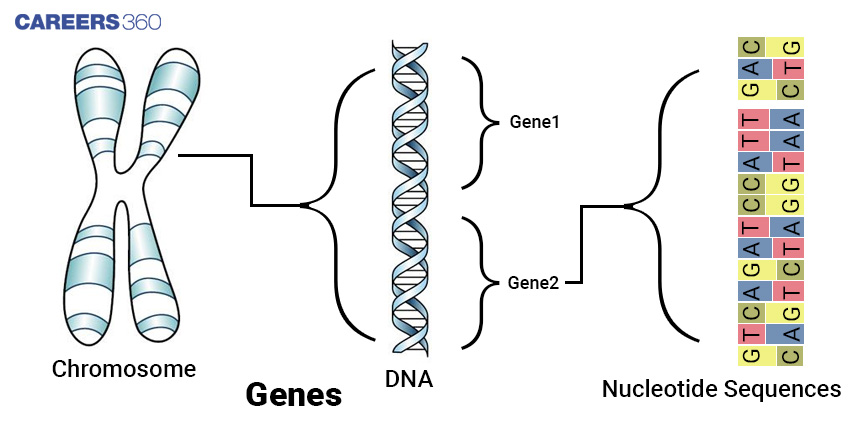This Class 12 Biology Chapter Explains Why You Resemble Your Parents
We all know that a human child has all the basic features that a human being should have. As well as, we have seen that we resemble our parents to a great degree. Even though the child doesn’t look like an exact copy of its parents because human beings show variation up to an extent.

The reproductive processes produce new individuals that are very similar but still, somehow different. Variation is the degree by which progeny differ from their parents. The variations among the individuals come into existence by the process of sexual reproduction. The key to both similarity and variation is in the genes that are passed on from parents to their offspring during sexual reproduction by a process known as an inheritance – the basis of heredity.
Genome: DNA, Gene, Nucleotide Sequence
A genome is defined as a complete set of all the genetic information present in an organism. This genetic information is present and carried in the linear sequence of nucleotides in DNA. So, like in human beings, DNA is the genetic material in most organisms. DNA is a long polymer of deoxyribonucleotides. A pair of nucleotides is referred to as a base pair. A gene is a subdivision of DNA that is made up of nucleotide sequences. Genes are called functional units – codes for functional molecules in an organism – of heredity because they are transmitted from the parents to their offspring, making them the basis of inheritance. Genes are located in or packed into, chromosomes.
Inheritance: Transmission Of Genetic Information
A set of chromosomes is passed from the father and another set of chromosomes is passed from the mother to their offspring or child during sexual reproduction. The DNA of inherited chromosomes contains all the genetic information in the form of a genetic code made up of four nucleotides – the building blocks of DNA.
The genetic code consists of codons that are made up of three out of four nucleotides- Adenine (A), Guanine (G), Cytosine (C), and Thymine (T). Each codon codes for a single specific amino acid. During protein synthesis, the sequence of amino acids in a newly formed protein is determined by these codons and eventually the protein function that influences the traits or characters of an individual.
Human Genome Project
We have learned in the preceding section that the genetic information of an organism is determined by the genetic code in DNA. With the help of genetic engineering techniques, a piece of DNA can be isolated and cloned. Then, nucleotide sequences in DNA can be determined by the process of DNA sequencing. This led to the determination of the complete DNA sequences of the human genome in 1990. When the entire genetic makeup of an individual or organism is determined, it is known as genome sequencing.
Facts About Human Genome
Here are some of the facts about the various components of the human genome – where they occur and in what numbers:
There are 23 pairs (that is, 46) of chromosomes in human beings
Human DNA is made up of 3 billion chemical base pairs (nucleotide bases)
Human DNA contains 20,000 to 25,000 genes.
An average gene of a human consists of 3,000 bases.
The functions of more than 50 percent of the discovered genes are yet unknown
Identical Or Similar – Genetic Difference
Chimpanzees and human beings share approximately 98.5 of their DNA. So, you would not be surprised if you were told that 99.9 percent of DNA is exactly the same in all human beings.
It suggests that it is only 0.1 percent of DNA that makes all people on earth look different from others. This 0.1 percent of DNA is responsible for different hair color, eye color, weight, height, ear shape, head shape, face shape – indeed all the features that make an individual unique – and thus can cause a variation in the phenotype of an individual. But, as genes are inherited from parents, they have instructions for various other characteristics such as instructions on biochemical, physical, and behavioral traits, even for diseases or genetic disorders, to offspring, making this a basis for resemblance to the parents.
Now the question that arises is that, even after sharing 99.9 percent of DNA, why do we not look identical but similar? The answer lies in the fact that even a single gene matters a lot in heredity because each gene can exist in its different form or in different sequences (alleles) giving rise to distinct phenotypes. So, when the chromosomes are passed on during sexual reproduction, the genes make different combinations or a sequence that codes for different characters or traits, or phenotypes.
These are the inherited traits that are passed on from one generation to the next but there are the traits that people develop during their lifetime due to the influence of various factors, known as acquired traits. These acquired traits are the changes in non-reproductive tissue that cannot be transferred to the DNA of a germ cell. So, we can conclude that acquired traits cannot be passed on from one generation to the next.
If 100 percent of DNA would have been the same, we would have been identical – that is, exactly the same – to each other.
Applications for Admissions are open.
As per latest syllabus. Physics formulas, equations, & laws of class 11 & 12th chapters
JEE Main Important Chemistry formulas
Get nowAs per latest syllabus. Chemistry formulas, equations, & laws of class 11 & 12th chapters
JEE Main high scoring chapters and topics
Get nowAs per latest 2024 syllabus. Study 40% syllabus and score upto 100% marks in JEE
JEE Main Important Mathematics Formulas
Get nowAs per latest syllabus. Maths formulas, equations, & theorems of class 11 & 12th chapters
